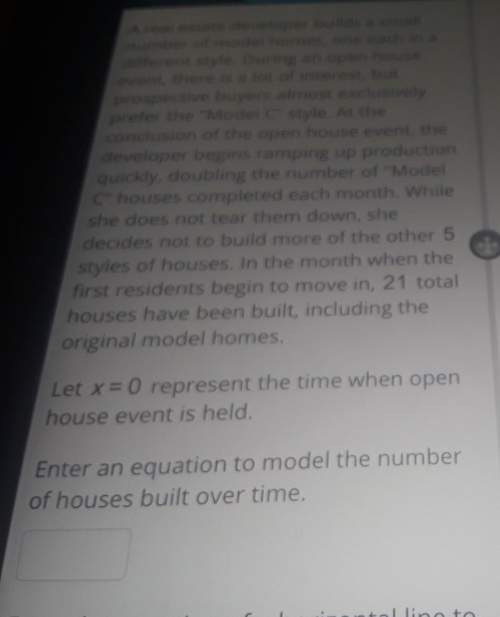
Mathematics, 09.01.2020 01:31 live4dramaoy0yf9
The distributive property also combines subtraction and multiplication. for example 3 times [5-2]= [3times5]-[3times 2]. explain how you could use the distributive property and mental math to find 5 times 198.

Answers: 2


Another question on Mathematics

Mathematics, 21.06.2019 21:00
Oliver read for 450 minutes this month his goal was to read for 10% more minutes next month if all of her medicine go how many minutes will you read all during the next two months
Answers: 3

Mathematics, 21.06.2019 23:00
1. an economy consists of three workers: larry, moe, and curly. each works 10 hours a day and can produce two services: mowing lawns and washing cars. in an hour, larry can either mow one lawn or wash one car; moe can either mow one lawn or wash two cars; and curly can either mow two lawns or wash one car. a. calculate how much of each service is produced under the following circumstances: a. all three spend all their time mowing lawns. b. all three spend all their time washing cars. c. all three spend half their time on each activity d. larry spends half of his time on each activity, while moe only washes cars and curly only mows lawns b. using your answers to part a, draw a production possibilities frontier and label points a, b, c, and d on your graph. explain why the production possibilities frontier has the shape it does. c. are any of the allocations calculated in part a inefficient? explain.
Answers: 3

Mathematics, 22.06.2019 00:00
Ascientist studied a population of workers to determine whether verbal praise and/or tangible rewards affect employee productivity. in the study, some workers were offered verbal praise, some were offered tangible rewards (gift cards, presents, and some were offered neither. the productivity of each participant was measured throughout the study by recording the number of daily tasks completed by each employee. which inference might the scientists make based on the given information? a.) the number of daily tasks completed by each employee may influence the dependent variable, which is whether the employee receives verbal praise, tangible rewards, or neither. b.) verbal praise and/or tangible rewards may influence the independent variable, which is the number of daily tasks completed by each employee. c.) verbal praise and/or tangible rewards may influence the dependent variable, which is the number of daily tasks completed by each employee. d.) the dependent variables, which are verbal praise and tangible rewards, may influence the number of daily tasks completed by each employee.
Answers: 1

Mathematics, 22.06.2019 02:30
The graph shows the amount of total rainfall at each hour what was the total rainfall amount after three hours
Answers: 1
You know the right answer?
The distributive property also combines subtraction and multiplication. for example 3 times [5-2]= [...
Questions

Health, 13.09.2019 21:10

Spanish, 13.09.2019 21:10



Mathematics, 13.09.2019 21:10


Mathematics, 13.09.2019 21:10

Mathematics, 13.09.2019 21:10




Engineering, 13.09.2019 21:10

Engineering, 13.09.2019 21:10











